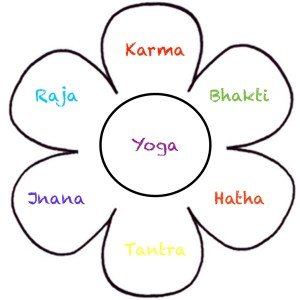The Six Traditional Branches of Yoga

As this ancient practice is being diluted down to 90 min (best case) of contortion, colourful leggings and coconut water, it’s time to rediscover what this whole yoga thing is all about.As you might already know, the word yoga is often translated as “union” or “connection” – as in connecting to the true self or consciousness. Yoga can also mean separation – as in separating the real from the unreal, truth from ignorance and the true self from the ego.Whilst there seems to be a “new yoga” almost every day (SUP Yoga, Naked Yoga, etc) and even though they may all be relevant to healing and serving each person who practices them, these all tend to focus on the asanas (the physical postures) and could all be classed as Hatha Yoga (see also my blog on the 8 limb of yoga).There is so much to learn about when it comes to yoga and you may even be surprised to know that asana is not only a very tiny part of it, but a tiny part of just one tiny branch of yoga.Here we’ll look closely at the six most widely practiced ancient branches or paths of yoga. More than just different styles of physical yoga, these branches have different histories, philosophies and intentions to each other – although it is possible to practice more than one together.
The six branches of yoga:
Karma yoga
Meaning: “The Yoga of Action”, also contemporarily known as the “Religion of Love”. The word “Karma” in this context is derived from the root verb “Kri” meaning “to do”. First mentioned around 300BC, this form of yoga is the main focus of the Bhagavad Gita. Karma yoga is based upon selfless service and acting without expectation of benefitting. It occupies a large part of Indian thought and through this practice, union with “the divine” is achieved.Karma yoga suggests that we relinquish attachment to the consequences of our actions and instead focus on the moment in action. Awareness of each thought, word and deed and mindfulness are an important part of Karma yoga, which allows the practitioner to truly experience that moment-in-action. Through the practice of Karma yoga, yogis work and act to benefit the people and the world around them in order to contribute towards facilitating a unified and “enlightened” world.
- Primary Practices: Mindfulness, selfless service, ahimsa (non-violence)
- Intended for: Householders. Many great saints were thought of as “Karma Yogis”, such as Gandhi and Mother Theresa.
Bhakti yoga
Meaning: Devotion. First mentioned in The Bhagavad Gita around 300BC, the word Bhakti comes from the root word “Bhaj”, of which the essence is “to share”. This form of yoga is based upon the heart, love and devotion towards a chosen deity (Ishta Devata). Much like Karma yoga, dedicating all actions towards a deity is an intrinsic part of Bhakti yoga. Much like other branches of yoga, Bhakti yoga has limbs (anga) for each practitioner to adhere to and take part in: – Shravana or “listening” to sacred scriptures – Kirtana “singing” of devotional songs – Smarana “remembering” the divine through meditation – Pada-sevana ritual worship or “service at the feet of the lord” – Vandana “prostration” before the image of god; – Dasya “slavish” devotion to god – Sakhya “friendship” through which the divine raises the devotee to the status of a friend – Atma-nivedana “self-offering”
- Primary Practices: Mantra, devotional rituals, meditation upon a chosen deity
- Intended For: Householders
Hatha yoga
Meaning: “The Yoga of Force”. Many teachers translate is as Ha to mean “Sun” and Tha to mean “Moon”, and reason that the physical yoga practice is intended to balance the Sun and Moon energies within us. Whilst the physical yoga practice is intended to bring about a state of equilibrium within the human organism, the real meaning and essence of Hatha yoga is to change the physical body and mind by way of experimentation, movement and physical force.Hatha yoga is anything that uses the physical body. It is what you are most likely to practice in class in some form, whether it’s called Hatha yoga, Vinyasa yoga, Power yoga or any of the other many styles of physical yoga. First mentioned and practiced around 1100AD, it is the most modern branch of yoga. This branch of yoga is – in a way – actually derived from Tantra and the most widely celebrated inventor of Hatha Yoga is Gorakshanath, who is considered a Maha-Yogi, or “great Yogi”.When it comes to Hatha yoga, liberation is attained through cultivating a Yoga-Deha – otherwise known as a “Yogic Body” (probably a little different to what we might consider a ‘yoga body’ to look like nowadays…) – which is immune to disease and free from limitations that ordinarily bind human beings.
- Primary Practices: Asana, Pranayama, Mudra, Meditation, Purification rituals, Bandha, Mantra, Kriya (anything related to the physical body).
- Intended for: Householders
Tantra yoga
Meaning: The root word of Tantra is “Tan” meaning “to expand” or “to weave”. It explores all aspects, sensations and energies that weave through the body and mind and actually began as a religion around 500BC. For over 1000 years it was the primary belief system of India in its less extreme forms and is the first time the physicality of the human body started to become important within a yogic context. Before this, much of a yoga practice was based upon worship, visualisation and meditation.Many people confuse Tantric yoga with ‘spiritualised sex’ – however, this isn’t the case. Whilst Tantra yoga includes many rituals, the ritualistic act of fornication is only reserved for a very rare ceremony for certain people. The fact that this branch of yoga permits mindful, purposeful and meaningful sex as opposed to no sex at all is probably why it has come to be known in such a way. Tantra is essentially the original form of non-dualism, and one-ness is very much a part of this branch of yoga. A large part of Tantra is focused upon the more subtle elements of the body, mind and life. Chakras, nadis, yantras, kundalini, and invocation of deities are a large part of Tantric yoga practices. The emphasis on expansion can be expressed by the practitioners of Tantra experiencing life’s fullness, expanding the mind beyond ordinary limitations. Much of Tantra is kept in obscurity, with the practices and rituals passed along secretively through oral tradition from guru to student or disciple.
- Primary practices: Mantra, Yantra, Kriya, Pranayama, Asana, Meditation, Visualisation
- Intended for: Householders
Jnana yoga
Meaning: Wisdom or knowledge. This is the yoga of “knowing”, of realising the truth of oneself. First mentioned around 400BC, this is thought of as one of the most direct paths to insight and illumination, but also as one of the most difficult. Priests and scholars are most likely to be considered Jnana yogis through their practice of constant inquiry. Jnana Yogis are often relatively ‘open minded’ and inquisitive about life and the process of yoga. Study of philosophical and yogic texts, along with discrimination and inquiry are the ways these practitioners understand the depths of the body, mind and spirit.
- Primary practices: Meditation and Svadhyaya
- Intended for: high caste royals who had the time, the education and the means to practice this.
Raja yoga
Meaning: “Royal” or “King”, alluding to being the “best” or “highest” form of yoga. Closely linked to Patanjali’s Eight Fold Path of Yoga, Raja yoga is also known as “Classical Yoga”.This path is precise and contemplative. It aims to control the intellect and thoughts through meditation. A connection with the consciousness is worked towards by un-identifying with the ego-based self and identifying with the universal true self. As a primarily interior practice with little outward spiritual expression, it is thought that Raja yoga requires much self-discipline.
- Primary practices: Meditation, Svadhyaya (self-inquiry and study of texts) and Tapas (self-discipline), Brahmacharya (purity)
- Originally intended for: only for high caste royals who had the time, the education and the means to practice this.
nice post :)
Thanks your image is a bit active haha
Very informative. I learned more about yoga in the two minutes of reading this than the last ten years of hearing about it via the general media and actual practitioners parleying on about it. Wish i had a place to practice it now.
well jdc yoga you can practice every where in my opinion glad you liked the article ill post more in the future
Thanks for sharing. Upvoted & followed. Nice seeing things like this on steemit.
Thank you very much magnick
Thanks for this.. nicely informative..followed 🙏